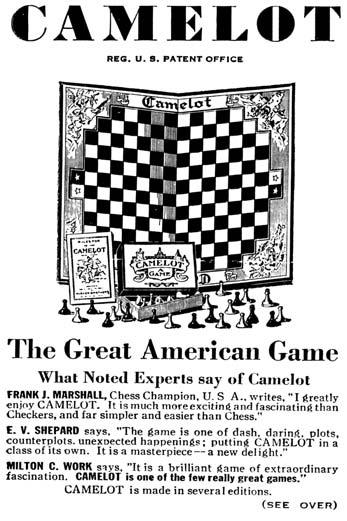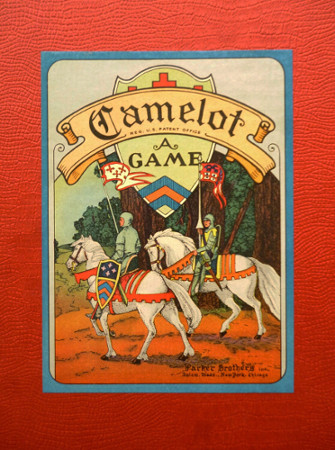Camelot, Cam, and Camette
Written by Howard Fosdick © BestFreeNewGames.com
Overview: Camette, Cam, and Camelot are a bit like a cross between checkers and chess. They play on a checkered board, use Knights and Pawns as their pieces, and involve jumping as in checkers. What makes them interesting is that they have their own unique rules and strategies.
All three games feature nearly the same rules. So if you learn to play one of them, you can play them all! This means that you can switch between the games, depending on whether your mood is for a simpler game like Camette, a more challenging game like Cam, or a chess-like battle in Camelot. The only difference between the games is the size of the playing area and the number of pieces involved. Yet that makes all the difference in terms of complexity.
Camelot was quite popular from the 1930s to the 1960s. It was accepted by many as equal in importance to checkers or chess during that period. Famous chess players like José Casablanca and Frank Marshall played it, as did bridge greats Sidney Lenz and Milton Work. John F. Kennedy grew up with it and enjoyed it as a boy. So, though you may have never heard of it, it's got quite a respectable reputation and history.
What if you don't have a set to play with? No problem. Just click here to download any of several free game boards.. You can use the Knights and Pawns from chess games as the men in these games.
We’ll describe the games in order of ascending complexity: Camette, then Cam, and then finally the chess-like Camelot.
Camette
Here's how the little Camette playing board appears, along with the initial positioning of pieces. Note that there are only two kinds of pieces, Knights and Pawns.

Objective:
You win either by occupying your opponent's castle with a single piece, or by eliminating all your opponent's pieces while having one left yourself.
The dots at opposite ends of the board denote the two castles.
Rules:
As in chess, white moves first to start the game. In his turn, a player moves one piece as follows:
1. Plain move -- a pawn or knight may move to any adjacent unoccupied square (vertically, horizontally, or diagonally).
2. The Canter -- a pawn or knight may move by jumping over any friendly piece to an unoccupied square on the other side of the jump. The move can be vertically, horizontally, or diagonally. The piece may make a series of continuing canter-jumps in one turn, and each may be in any direction. You do not remove the piece(s) cantered over, and you are never compelled to canter. You can not end a canter on the same board square on which you started.
3. The Jump -- a pawn or knight can move by jumping over an enemy piece to an unoccupied square on the other side of the jump. The jump can be made vertically, horizontally, or diagonally.
Jumping an enemy piece captures it, and it is immediately removed from the board.
A piece may make a series of continuing jumps in one turn, and jumps may be in different directions. You are compelled to jump if possible, and to continue a jump series as long as it is possible. When confronted by alternative jumps you may choose which to take. Remove all enemy pieces that have been jumped from the board.
If confronted with a situation where more than a single piece can jump, you have the choice as to which jump to make. You can also elect to perform a Knight’s Charge instead of a jump, if it is possible.
4. The Knight’s Charge -- Only knights may combine cantering then jumping into a movement called the Knight’s Charge. The cantering must occur first, then the jumping. All the rules of canters and jumps apply -- they may occur in any direction (vertically, horizontally, and diagonally), and the directions may change during the move. Jumps are compulsory, although if you have alternate routes that each supply one or more jumps, you may choose which jumping route to take.
A player can never plain-move or canter into or through his own Castle. However he is allowed to end up on his own Castle as a result of a jump. Should this occur the player is required to move his piece out of his own Castle on the very next turn (no exceptions).
That’s it! Now onto Cam and Camelot...
Cam and Camelot
George S. Parker founded Parker Brothers, the games company, in the 1880s when he was a teenager. He invented all the company's early games himself and wrote their rules. One of his inventions from the 1880s was Chivalry. He developed it further into the game that became Camelot.
Cam was invented as a simpler form of Camelot in 1949. Though it never achieved the popularity of its parent game, it does offer a nice balance between playability and complexity.
Here is the smaller board for Cam, as well as the larger Camelot board. Click on either for a printable version. Both illustrations show the initial positioning of each players' men:


The rules for Cam are the exact same as for Camette. (That was easy, wasn't it?)
Camelot Rules:
Camelot rules are the same as Camette and Cam except:
- You must occupy both squares of the opponent’s Castle to win.
- To win in Camelot by eliminating all the opponent’s pieces, two of your own pieces must remain (not just one).
- Stalemate is possible in Camelot but not in Camette or Cam. Stalemate can occur, for example, if each side has 1 remaining piece.
-----------------------------------
Print Your Own Game Board:
Want to print your own game boards? Click here to download free printable game boards for this or any other game on this website.
-----------------------------------
Playing on Your Computer:
Zillions of Games and other websites let you play Cam and Camelot.
-----------------------------------
Sources:
The ultimate source of rules on all Camelot-related games is the World Camelot Federation. WCF have everything about the game including: history, rules, strategy, variations, pictures of old boards and pieces, and more. Thank you to the WCF for permission to use the black and white board graphics that appear on this webpage (the printable colour boards were created by H. Fosdick).
-----------------------------------
President Kennedy and Camelot:
President John F. Kennedy grew up playing Camelot. Ironically, his administration (1960-63) ended up being referred to as “Camelot” by many in the press. The term originated with his widow Jackie, who used it to describe his presidency as a period of hope and optimism shortly after his assassination.
The photo below shows President Kennedy’s Camelot set along with its certificate of authenticity:



-----------------------------------
If you like board games, see our pages on Teeko, Ringo, the Jungle Game, and Brandubh and Fitchneal.
Click here for more free games on this website.
-----------------------------------
License: Feel free to print, copy, and distribute these rules, so long as you retain this paragraph. Written by Howard Fosdick © 2023, distributed under Creative Commons License BY-ND. HOME